- Clone
- IK22/5 (See other available formats)
- Regulatory Status
- RUO
- Other Names
- Tumor necrosis factor-related activation-induced cytokine, Receptor activator of NF-κB ligand (RANK L), Osteoprotegerin ligand (OPGL), Osteoclast differentiation factor (ODF), SOFA, TNFSF-11, CD254, RANKL
- Isotype
- Rat IgG2a, κ
- Ave. Rating
- Submit a Review
- Product Citations
- publications
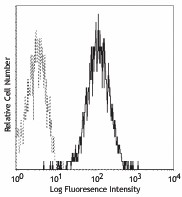
-

TRANCE transfected cells stained with IK22-5 PE
| Cat # | Size | Price | Quantity Check Availability | Save | ||
|---|---|---|---|---|---|---|
| 510005 | 50 µg | 156€ | ||||
| 510006 | 200 µg | 322€ | ||||
CD254 is a 19 kD TNF superfamily member also known as TRANCE (TNF-related activation induced cytokine), RANK ligand, RANKL, TNFSF11, OPGL, and ODF. TRANCE is expressed on activated T cells and osteoclasts and has been implicated in the regulation of T cell and dendritic cell interactions as well as osteoclast differentiation.
Product DetailsProduct Details
- Verified Reactivity
- Mouse
- Antibody Type
- Monoclonal
- Host Species
- Rat
- Immunogen
- NSO-derived recombinant mouse TRANCE
- Formulation
- Phosphate-buffered solution, pH 7.2, containing 0.09% sodium azide.
- Preparation
- The antibody was purified by affinity chromatography, and conjugated with PE under optimal conditions.
- Concentration
- 0.2 mg/ml
- Storage & Handling
- The antibody solution should be stored undiluted between 2°C and 8°C, and protected from prolonged exposure to light. Do not freeze.
- Application
-
FC - Quality tested
- Recommended Usage
-
Each lot of this antibody is quality control tested by immunofluorescent staining with flow cytometric analysis. For flow cytometric analysis, the suggested use of this reagent is ≤ 0.25 µg per 106 cells in 100 µl volume. It is recommended that the reagent be titrated for optimal performance for each application.
- Excitation Laser
-
Blue Laser (488 nm)
Green Laser (532 nm)/Yellow-Green Laser (561 nm)
- Application Notes
-
The IK22/5 antibody has been reported to block the binding of RANK ligand-Fc to RANK. Additional reported applications (for the relevant formats) include: immunoprecipitation2, Western blotting2, and blocking of ligand binding1,2,4. The Ultra-LEAF™ purified antibody (Endotoxin <0.01 EU/µg, Azide-Free, 0.2 µm filtered) is recommended for functional assays (Cat. No. 510009-510014).
-
Application References
(PubMed link indicates BioLegend citation) -
- Miyahira Y, et al. 2003. J. Immunol. 171:6344. (Block)
- Personal communication (Block IP WB)
- Gao Y, et al. 2007. J. Clin. Invest. 117:122.
- Kamijo S, et al. 2006. Biochem. Biophys. Res. Commun. 347:124. (Block)
- Fionda C, et al. 2007. J. Immunol. 178:4039.
- Haslam SZ, et al. 2008. Endocrinology. 149:2098. (Block) PubMed
- Product Citations
-
- RRID
-
AB_315553 (BioLegend Cat. No. 510005)
AB_2303587 (BioLegend Cat. No. 510006)
Antigen Details
- Structure
- TNF superfamily; 19 kD (Mammalian)
- Distribution
-
Activated T cells, osteoclasts
- Function
- Regulates T and dendritic cell interactions, and osteoclast differentiation
- Ligand/Receptor
- RANK, OPG
- Bioactivity
- Activates JNK and NF-κB; involved in bone resorption; induces the expression of IL-1, IL-6, IL-12, IL-15 in dendritic cells
- Cell Sources
- Activated T cells, myeloid bone marrow precursors, stromal fibroblasts, synovial cells, osteoblasts
- Cell Targets
- Dendritic cells, osteoclasts
- Receptors
- ODFR, ODAR, TRANCE-R
- Cell Type
- Osteoclasts, T cells
- Biology Area
- Cell Biology, Immunology
- Molecular Family
- CD Molecules, Cytokines/Chemokines
- Antigen References
-
1. Fitzgerald K, et al. Eds. 2001. The Cytokine FactsBook. Academic Press San Diego.
2. Josien R, et al. 1999. J. Immunol. 162:2562.
3. Takayanagi H, et al. 2000. Nature 408:600.
4. Wong B, et al. 1999. Mol. Cell. 4:1041. - Regulation
- Type II integral membrane protein processed by TACE for secretion; upregulated upon TCR engagement
- Gene ID
- 21943 View all products for this Gene ID
- UniProt
- View information about CD254 on UniProt.org
Related FAQs
- What type of PE do you use in your conjugates?
- We use R-PE in our conjugates.
Other Formats
View All CD254 Reagents Request Custom Conjugation| Description | Clone | Applications |
|---|---|---|
| Biotin anti-mouse CD254 (TRANCE, RANKL) | IK22/5 | FC |
| PE anti-mouse CD254 (TRANCE, RANKL) | IK22/5 | FC |
| Purified anti-mouse CD254 (TRANCE, RANKL) | IK22/5 | FC,IP,WB |
| Ultra-LEAF™ Purified anti-mouse CD254 (TRANCE, RANKL) | IK22/5 | FC,IP,WB,Block |
Customers Also Purchased
Compare Data Across All Formats
This data display is provided for general comparisons between formats.
Your actual data may vary due to variations in samples, target cells, instruments and their settings, staining conditions, and other factors.
If you need assistance with selecting the best format contact our expert technical support team.
-
Biotin anti-mouse CD254 (TRANCE, RANKL)
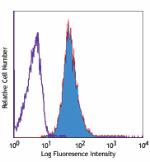
Mouse TRANCE transfected cells stained with biotinylated IK2... -
PE anti-mouse CD254 (TRANCE, RANKL)
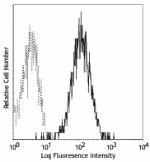
TRANCE transfected cells stained with IK22-5 PE -
Purified anti-mouse CD254 (TRANCE, RANKL)
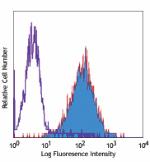
Mouse TRANCE transfected cells stained with purified IK22-5,... -
Ultra-LEAF™ Purified anti-mouse CD254 (TRANCE, RANKL)

Mouse TRANCE transfected cells stained with Ultra-LEAF™ Puri...
 Login / Register
Login / Register 













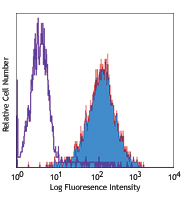
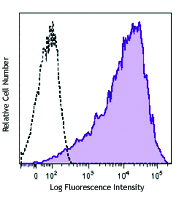




Follow Us